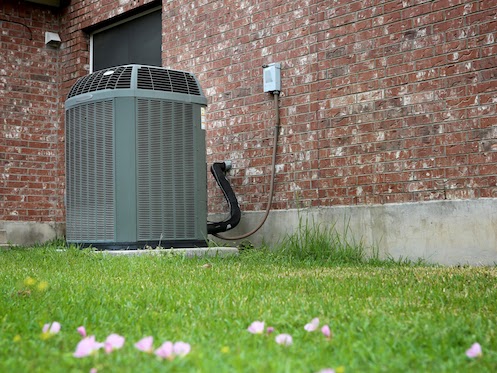Many people experience allergy symptoms year-round. Pollen from plants, pet dander, pollution, dust particles, and mold spores are just some of the things that people can react to. When you’re experiencing symptoms like a runny nose, itchy eyes, a sore throat, trouble breathing, or persistent sneezing, you may head indoors to find relief. However, many homes in the Oklahoma City area experience poor indoor air quality. In fact, the Environmental Protection Agency suggests that indoor air can be up to five times more polluted than outdoor air. Fortunately, proper HVAC maintenance and adding air purification can improve your home’s indoor air quality and provide some relief for allergies.
Your HVAC Filter
There is a filter that is part of your HVAC system that removes particulates from the air that is flowing through your equipment. These filters generally need to be replaced once every 30 to 90 days, depending on the type that you’re using. Not only will this filter help reduce the allergens in the air you’re breathing in your home, but it also helps to protect your HVAC system. If too many particulates accumulate on the inner components of your heater or air conditioner, it can lead to your unit being overworked and strained. In turn, this leads to more repairs over time.
You can choose different types of filters for your HVAC system that are effective for removing various allergens. HVAC filters are usually rated using the MERV scale, which stands for minimum efficiency reporting values. The higher the MERV rating, the more airborne particulate matter the filter captures. While you may want to run to the store and buy the highest-MERV-rated filter that you can find, this isn’t necessarily a good idea. If your HVAC equipment can’t handle a high-MERV-rated filter, it can cause damage to your system. It’s a good idea to speak with an experienced HVAC professional who can provide you with some guidance on what kind of filter to purchase based on your setup. You should keep in mind that higher-quality filters need to be replaced more frequently than generally recommended because they capture more debris.
Air Filtration Devices
There are different air filtration devices that you can use in your home to purify the air from common allergens. Many people opt for standalone units that can be moved from one room to another. While these units can be effective, they are not powerful enough to treat all of the air inside your home.
Alternatively, you can choose to have an HVAC technician install a whole-home air purifier. They can be integrated into your current system, and many models work in conjunction with smart technology, including advanced thermostats. When appropriately sized for your home, this equipment will adequately remove most of the allergens that you’re dealing with.
HEPA Filters
HEPA filters can remove approximately 99.97% of the dust, pollen, dander, and mold spores in your indoor air. These types of filters are not compatible with residential heating and cooling systems. However, whole-home air filtration devices can handle a HEPA filter and allow for optimal airborne contaminant filtration in your home.
Whole-home purification systems are often equipped with other features that can help further purify your indoor air. This includes UV light technology, which can eliminate pathogens and microorganisms from the air you breathe. This means fewer illnesses spread around your home. When you’re already dealing with allergies and potentially asthma, reducing the chances of catching a cold makes sense.
Carbon Filtration
Carbon filtration is a great method of purifying your indoor air. You can find air filters that use activated carbon filtration technology for your HVAC system. Additionally, this type of filtration can be found in many whole-house air purification systems.
Activated carbon is a highly porous material known for its exceptional adsorption capabilities. As air passes through the filter, the activated carbon effectively captures and traps various pollutants, including odors, volatile organic compounds (VOCs), and airborne particles. VOCs come from different sources, such as new building materials, furniture, paint, chemical-based cleaning, and even everyday activities like cooking. Breathing these VOCs over time has the potential to cause several health problems, such as an increase in asthma attacks, allergy symptoms, headaches, and more.
Duct Cleaning
A professional duct cleaning can reduce allergy symptoms by removing accumulated dust, debris, and allergens from the ductwork. Over time, ducts can become a breeding ground for allergens such as pollen, pet dander, mold spores, and dust mites. When your HVAC system runs, these allergens can be circulated throughout the home, exacerbating allergy symptoms and triggering respiratory issues for sensitive household members. Duct cleaning can provide a noticeable improvement in indoor air quality, providing relief for allergy sufferers and promoting healthier living conditions.
Duct cleaning also gives the HVAC technician performing the work an opportunity to check your forced air system for gaps and leaks. Repairs are usually simple and will prevent airborne contaminants from areas like attics and crawl spaces from entering your heating and cooling system.
Annual Maintenance
Experts recommend that you have your heating and cooling systems tuned up at least once a year. This annual maintenance visit ensures that your systems run efficiently and extends the lifespan of your equipment. However, tune-ups are also vital to your indoor air quality.
During routine maintenance, an HVAC technician cleans the internal components of your equipment. They will remove dirt, allergens, and debris that may otherwise recirculate through your living spaces. In addition, heating and cooling systems that are clean and tuned-up properly are effective at circulating air throughout your home and improve indoor air quality.
Humidity Control
Whole-home humidity control systems offer significant benefits in reducing allergy symptoms by maintaining optimal indoor humidity levels. Like air purifiers, they can be incorporated into your current HVAC system by a professional, and many whole-house models are compatible with smart technology. They work by regulating humidity levels throughout your home, ensuring that the air remains within the ideal range of 30% to 50%.
By controlling indoor humidity, these systems help to mitigate the growth of mold, mildew, and dust mites, all of which thrive in environments with high moisture levels. Additionally, maintaining proper humidity levels can help alleviate symptoms associated with dry air, such as irritated sinuses, dry skin, and aggravated respiratory conditions. By providing a comfortable and balanced moisture level, whole-home humidity control systems can improve respiratory health and overall well-being for occupants, especially allergy sufferers.
Contact the Professionals
At True Climate Heat + Air, we understand how overwhelming it can feel to try to tackle your allergy symptoms in Oklahoma City, OK. We encourage you to give our team a call so that we can assist you with an indoor air quality assessment. We’ll help you develop ways to improve your indoor air quality so that your home can become a refuge from allergy symptoms where you can enjoy your free time.
In addition to improving indoor air quality, we install, repair, and maintain heating and cooling systems. We are also expert plumbers who provide garbage disposal, water heater, and drain cleaning services. Contact us today to schedule an appointment with one of our team members.


